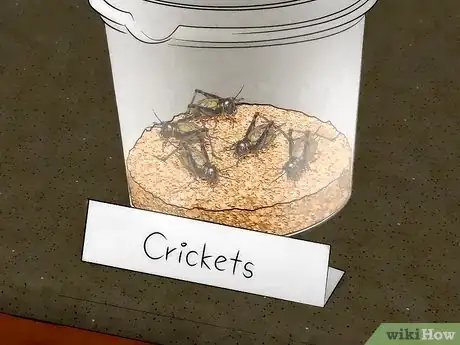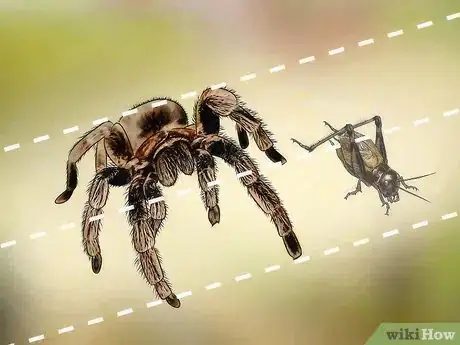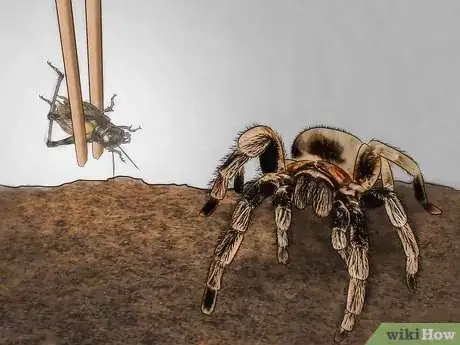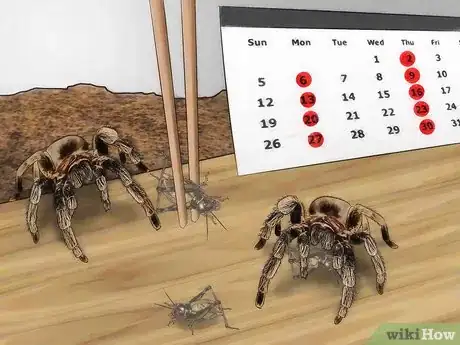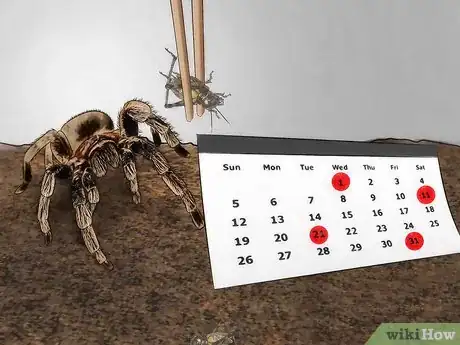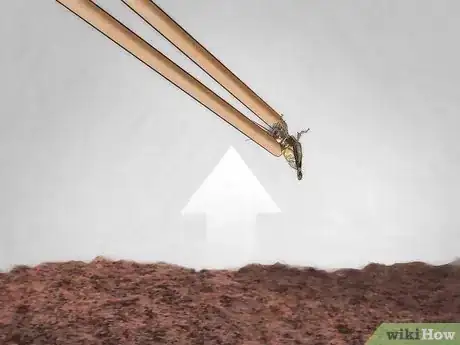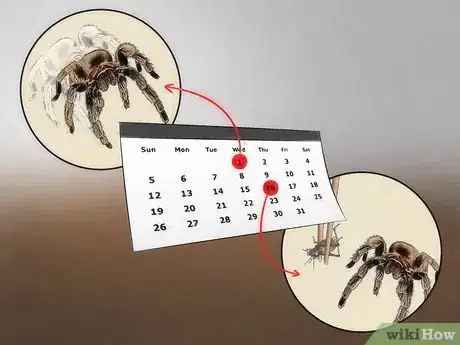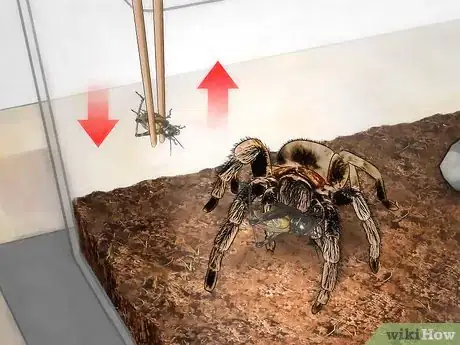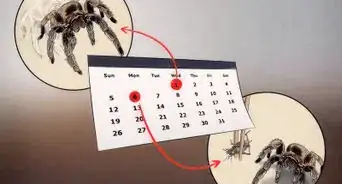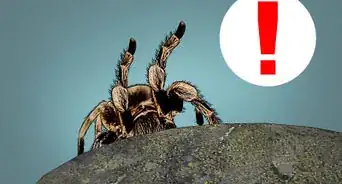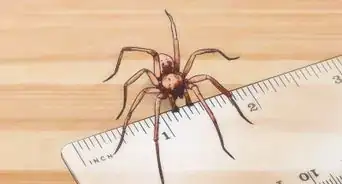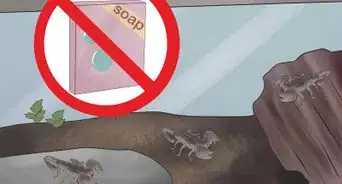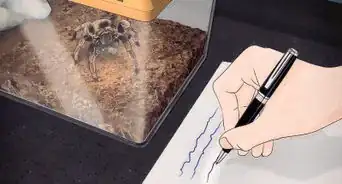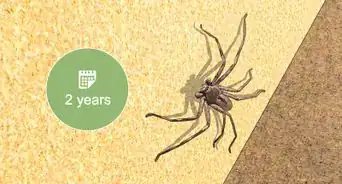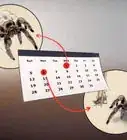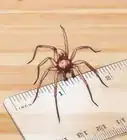This article was co-authored by Pippa Elliott, MRCVS. Dr. Elliott, BVMS, MRCVS is a veterinarian with over 30 years of experience in veterinary surgery and companion animal practice. She graduated from the University of Glasgow in 1987 with a degree in veterinary medicine and surgery. She has worked at the same animal clinic in her hometown for over 20 years.
wikiHow marks an article as reader-approved once it receives enough positive feedback. In this case, 94% of readers who voted found the article helpful, earning it our reader-approved status.
This article has been viewed 101,973 times.
Tarantulas don't need to be fed often, but that doesn't mean caring for them is easy. Your tarantula eats live prey. This means you will be caring for a community of crickets as well as caring for a spider. Change your tarantula's water daily, and clean any food remains from its cage after a day.
Steps
Shopping for Tarantula Groceries
-
1Buy crickets and other creatures. Crickets are always a safe bet, as all tarantulas are insectivores. Depending on the tarantula, live grasshoppers, katydids, moths, mealworms, superworms), houseflies or cockroaches might also provide a welcome meal. Some tropical tarantulas will eat larger worms, like earthworms, and some larger tarantulas will accept live baby rodents, mice, lizards, and snakes.[1]
- You can buy live crickets and other prey online or in pet stores. Buy insects in tubs or bulk orders, and keep them alive and well-fred.
-
2Size the prey. The ideal size for your tarantula's prey is about half the tarantula's leg span, or slightly smaller than the length of its body. Though large tropical spiders sometimes eat prey as large as themselves, in most cases you should opt for smaller creatures. Large prey may fight back and exhaust your spider.
- A young tarantula of about 4 weeks old may have a two-inch leg span and a one-inch body, so you would feed it a cricket of about ¾ inch in length.
- Baby tarantulas are sometimes willing to scavenge dead insects, so if your crickets are too big you can cut them into appropriately sized portions.
- If your insects are small, you can serve up to four at a time to a large tarantula. However, this may cause your tarantula stress, and you may wish to serve them one at a time or to buy larger insects.
Advertisement -
3Make a cricket cage. Buy a large plastic storage box with a secure lid. The box should be deep, about 14 inches, so that the crickets can't easily hop out when you take the lid off. Use a soldering iron or a sharp object to poke two hundred or more holes in the lid and along the rim of the box. The hole should be small enough that the crickets can't fit through.
- Humidity will kill the crickets. Keep the box in a dry place, and don't overcrowd it. You can store about a 1000 crickets in a 18 by 14 inch box.
- Put egg cartons and toilet paper tubes in the box for the crickets to climb over and hide on. This will prevent the crickets from crowding along a single surface and generating humidity.
- When you want to harvest some crickets to feed your spider, put a plastic bag in the box and shake a toilet paper tube or section of egg carton into it. The crickets hidden within will fall in the bag.
-
4Feed the crickets. All the nutrients your tarantula gets come from its food. A well-fed cricket will nourish your tarantula better than a starved one. Keep a shallow container of dry oats in the cage, or buy bug food and cricket-specific supplements. Try to keep the food in one corner of the cricket habitat, so that it is less likely to become contaminated or moldy.
- For moisture and nutrients, place a whole carrot in the cage. Remove it if it decomposes or molds.
- Crickets will also eat leafy greens, such as broccoli, collards, or cabbage, as well as potatoes, fish flakes, and reptile food.[2]
- Soak cotton balls in water, put them in a lid, and pop this in the cricket cage. This will let the crickets drink without drowning.
Serving Tarantula Meals
-
1Put live prey in the cage. The best practice is to place one live insect or other creature in the tarantula's cage. Let your tarantula eat at its own pace. If the insects you have are too small to make a full single-serving meal, you may put several in the cage at once. Your tarantula may attack them all in succession, rolling them up into a "bolus" with its webbing, then eat them all at once.
- In the case of too-small insects, some tarantula owners prefer to put them in the cage one at a time over several days, so that the tarantula does not experience stress or harassment from uncaught prey.
- If you have put a large creature in the cage and are worried it may harm your tarantula, keep an eye on it and remove it if you think you have overestimated your tarantula's current state of strength and appetite.
-
2Dangle prey if necessary. Baby tarantulas will often scavenge, and adult tarantulas will on occasion. In most cases, however, your full-grown tarantula will not recognize food unless that food moves. If you think your tarantula has failed to recognize live prey that is holding very still, try poking the prey lightly to induce movement.
- If you would like to induce your tarantula to eat food that is dead or holding still, such as a frozen pinkie mouse, you can also dangle it from the end of a string to make it seem lifelike.
-
3Provide a shallow dish of water. Pick a shallow dish, less than an inch in height. Fill it daily with about half an inch of water. The water should be just deep enough for your tarantula to submerge its fangs. You can buy a dish from a pet store, or use the lid of a jar.[3]
- Change the water daily, and replace the dish if it is molding or rusting.
- Tarantulas do not drink often, as they receive most of their moisture from their food. However, they do drink at times, and they benefit from having some water around to create environmental moisture
- Tropical tarantulas, such as Avicularia Versicolor, living in dry environments may benefit from having areas of their cage misted with water every 2-3 days, then allowed to dry out entirely. Check the specifications for your species.
- Do not purchase "cricket gel" or sponges. Though some pet stores still sell them, they have been discredited as a source of moisture for your tarantula, and will quickly mold.[4]
Timing Tarantula Meals
-
1Feed baby tarantulas often. Offer appropriately-sized portions of food to young tarantulas once or twice a week. Underfeeding could cause your spiderling to dehydrate and die. Some tarantula owners feed baby tarantulas every day to encourage growth. It is not known whether spiderlings are harmed by over-feeding, but this practice can harm other similar animals.[5]
-
2Feed adult tarantulas less frequently. Your fully grown spider will likely accept prey every 10-14 days. It is not uncommon, however, for a spider to abstain from eating for a full month after a large meal. Tarantulas will keep eating until they are full. They will abstain from eating when they are soon to molt, or preparing to lay eggs.
-
3Remove uneaten food. Clear leftovers from the cage within 24 hours of serving. This includes live insects as well as half-eaten insect parts, such as the bolus. Leaving insect corpses in a cage is unsanitary, as it attracts pests and mold. Leaving live insects in the cage will cause your tarantula stress.[6]
- Try feeding your spider at night, and cleaning out the remains in the morning.
-
4Do not feed a molting tarantula. A freshly molted baby tarantula does not need to be fed for several days. An adult tarantula that has just molted will not eat for two weeks. Be sure to remove prey from the cage of a recently molted tarantula for at least three days, as the tarantula's skin will still be soft and vulnerable enough for a cricket to harm it.[7]
- Your tarantula will probably stop eating prey a few weeks before it molts.
- You can tell your tarantula has molted because it will lie on its back for 15 minutes to several hours.
- It may have webbing on its body, clear drops of fluid seeping from its legs, or a bald spot on its abdomen.
- It will then emerge from its old skin, possibly with a regenerated limb or two.
-
5Make adjustments when necessary. Tarantulas are generally good at self-regulating their meals. However, tarantulas that don't eat enough suffer malnutrition, and adult tarantulas are sometimes capable of overeating, so keep an eye on your tarantula's abdomen. If the abdomen is shriveled, it means your tarantula is underfed and dehydrated. If the abdomen is so large your tarantula has trouble getting around, you may need to feed your tarantula less frequently.
References
- ↑ http://www.tarantulas.com/care_info.html
- ↑ http://www.tarantulapets.com/what-do-tarantulas-eat/
- ↑ http://www.tarantulapets.com/do-tarantulas-drink-water/
- ↑ http://www.tarantulas.com/care_info.html
- ↑ http://www.tarantulas.com/spiderlings.html
- ↑ http://www.tarantulas.com/care_info.html
- ↑ http://www.tarantulaguide.com/tarantula-molting/
About This Article
To feed a tarantula, start by buying live crickets or other small insects at a pet store or online. Next, place 1 cricket into your spider's cage and allow it to stalk its prey at its own pace. If it seems like your tarantula isn't recognizing the cricket as food, poke the cricket to get it moving around. Feed full-grown tarantulas 1 cricket every 10-14 days, although some adults may abstain from food for up to a month. If you have a baby, feed it 1-2 times per week to keep it healthy. Don't forget to provide a shallow dish of fresh water for your spider every day! For tips on buying and storing live crickets, read on!
